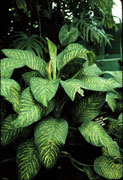


Home
Flowers &
Indoor Plants
Fruits & Nuts
Ornamentals
Vegetables
Special Topics
Resources
Glossary

|
Dumbcane, Dieffenbachia Dieffenbachia amoena (dee-fen-bok-ee-ah ah-mee-na) Click on thumbnails for larger image. |
 |
What about it? The work "dumb" is drived from the extremely unpleasant sensation this plant can give the mouth if consumed. It contains irritants. Dumb cane comes from a family Araceae of tropical plants characterized by a thick, unbranched stem and large, oblong leaves. Depending on the species, dumb cane will grow up to 6 feet tall and can have leaves as long as 18 inches. Its leaves often have narrow white or yellow stripes on either side of the midrib. There are also Spotted Dumb Cane varieties, D. maculata and D. picta, with yellow markings and a "Rudolph Roehrs" variety (D. roehrsii) with pale chartreuse and ivory coloration. What is it used for? Dumb cane is an attractive indoor plant or patio plant during the summer months. It should not be grown near small children! Where does it grow? How do we grow it?It likes medium sunlight and warmer temperatures. Soil should be kept on the dry side. Use sphagnum moss if available. What are its primary problems? Dumb canes typically have problems with red spider mites and mealy bugs. They also tend to become 'leggy" meaning that they lose their lower leaves. The name "dumb cane" refers to the fact that that the sap of this plant makes one unable to speak and therefore "dumb". How do we propagate it? Propagation through air layering, cane cuttings, and terminal cuttings will be successful.
© Copyright, Department of Horticulture, Cornell University. |